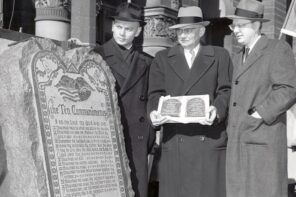Ten Questions for Kathryn Joyce on Quiverfull: Inside the Christian Patriarchy Movement, (Beacon Press, 2009).
What inspired you to write Quiverfull? What sparked your interest?
I first came across the Quiverfull movement while researching the anti-contraception movement among pro-life pharmacists claiming “conscientious objections” to dispensing birth control. I had been unaware of anti-abortion claims that birth control functions as abortion, and hadn’t known that opposition to contraception had become an important issue among Protestants and evangelicals in addition to traditional opponents among Catholic and LDS churches. Looking into some of the groups that were supportive of the pharmacists’ movement, though, I came across a surprisingly well-organized coalition of evangelical anti-contraception groups, some of whom were arguing that Christians should leave their family size and spacing in the hands of God. As I began to read a number of books that shaped the community and conviction, particularly early movement texts like Mary Pride’s The Way Home: Beyond Feminism, Back to Reality, and Rick and Jan Hess’ Full Quiver: Family Planning and the Lordship of Christ, I began to see a vehement anti-feminism and another, startling motivation for large Christian families as well, as the Quiverfull authors told readers that by having very large families, and teaching their children to do the same, they could win the culture wars through numbers alone.
What’s the most important take-home message for readers?
My main concern about these convictions is not so much the plans for Christian dominion that Quiverfull authors and homeschooling ministries discuss, but rather that in the service of these ideas, many women are subjecting themselves to an often punishing lifestyle. Quiverfull is not just about the openness to many children, but goes hand in hand with a self-described “patriarchy” movement, where women follow strict versions of the doctrine of headship and submission and strive to always remain under the protective “covering” or authority of their husbands and fathers. These positions are becoming more mainstream, particularly through the growth of complementarianism or “biblical manhood and womanhood” teachings in mainstream evangelical churches. Like many of the women I spoke to who came to follow Quiverfull and patriarchy not from a fundamentalist background but through “maturation” outreach within the church – Bible studies and women’s groups that introduce submission and headship to female congregants – it seems that many evangelical churches are rigidifying their attitudes towards women as a whole.
Anything you had to leave out?
Because this movement is still growing, interesting events and developments have continued to happen all throughout the past year, such as the Department of Health and Human Services’ radical expansion of conscience clause regulations last fall, or some interesting “biblical womanhood” events, such as the True Woman Conference in Chicago. Also since completing the book, I’ve met and had more conversations with Christian women who are working to challenge some of the tenets of the Quiverfull and patriarchy lifestyles, whose voices I would have liked to include with those of other dissenters in the book.
What are some of the biggest misconceptions about your topic?
A common misconception about Quiverfull seems to spring from popular representations of it in the spate of large-family TV shows over the past few years, which focus on the novelty of unusually large families, and not on the theology that underlies their decisions. Through these representations, the movement is depicted as an innocuous lifestyle choice with no impact or relevance to the outside culture. I think it’s important to emphasize that the lifestyle is the purist edge of a widespread anti-feminism among conservative Christians, promoting a vanguard of large patriarchal families as an ideal for others to emulate, and attempting to popularize the conviction by tying the Quiverfull ideal to the demographic future of the West.
Did you have a specific audience in mind when writing?
I thought the book would most appeal to feminist readers, whether religious or secular, who were concerned about what seems a growing backlash against women’s rights within religious communities, and the fierce denunciations of feminism from the right. I’ve been very pleasantly surprised to see that the book has attracted some attention from a religious audience as well, many of whom said the book was a fair exploration of a lot of questions they’ve witnessed play out in their congregations.
Are you hoping to just inform readers? Give them pleasure? Piss them off?
Inform and piss off, I guess. In general, more people need to know about these topics. A lot of people find it hard to believe that this movement exists, and there’s certainly a “news of the weird” part of any story about an 18-child family. But whether people approach such news as something freakish or something beautiful, there’s so much more to the conviction than the novelty of such large families. I think most readers would be shocked and surprised, as I was, to read what a dramatic reversal of women’s rights the Quiverfull and patriarchy movements desire, and what smart organizing and advocacy they’re doing on behalf of that goal.
What alternate title would you give the book?
My working title for the book was “Trust and Obey.” That’s the name of an 1800s Presbyterian hymn that is frequently referenced by Quiverfull supporters that reads: “Trust and Obey, for there’s no other way/ to be happy in Jesus but to trust and obey.” The sentiment of the hymn really sums up the role of faith in this movement—ultimately, beyond the demographic dreams of Vision Forum and the Hesses, this movement relies on women having a faith strong enough to convince them to have children they may not necessarily be able to provide for, but to trust instead that God will take care of them if they are obedient. It’s a deceptively simple challenge to any woman who is having second thoughts about giving up so much self-determination.
How do you feel about the cover?
I think Beacon did a fantastic job in conceptualizing a number of the ideas in the book with this cover, which includes a male hand clenching a fistful of arrows. In Quiverfull, as parents seek to have a “full quiver” of children, the children become “arrows” in their parents’ arsenal, following the model of Psalm 127, “Like arrows in the hands of a warrior, so are sons born in one’s youth. Blessed is the man whose quiver is full of them. They shall not be put to shame when they contend with their enemies in the gate.” Although the fist and arrows were inspired in part by some of the literature in the Quiverfull movement, it’s also reminiscent of some fascist iconography and that ideology’s preoccupation with population and breeding.
Is there a book out there you wish you had written? Which one? Why?
There are a lot, but right now, Ellen Willis’ Beginning to See the Light or Mothers in the Fatherland by Claudia Koonz. I had the privilege of studying with Ellen Willis before her death several years ago, and Beginning to See the Light still amazes me for Willis’ equally unsentimental and far-reaching idealism with regards to the possibilities of the women’s liberation movement, starting with her intellectually-rigorous investigation of what’s often dismissed as a 60s-era cliché, “that there really is such a thing as liberation.” Researching Quiverfull, I read many fundamentalists who took that charge seriously enough to counter it, and tell women that there was no such thing as freedom, but only slavery to sin or to God. Koonz’s book is a meticulous history of women during wartime Germany—the resurgence of patriarchal gender roles, their movements for and against these roles, the politicking of Germany’s versions of Phyllis Schlafly, angling for power with male leaders as they built up armies of submissive women.
What’s your next book?
I’m not sure yet…




